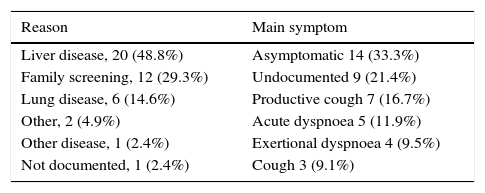Alpha-1 antitrypsin (AAT) is a protein whose main function is the inactivation of neutrophil elastase. The gene that encodes AAT is transmitted by simple Mendelian inheritance in an autosomal codominant pattern in two alleles, one from each parent. The normal allele is known as PiM. The most frequent deficient alleles are PiS and PiZ, which encode abnormal proteins that polymerise in the liver so that 80–90% of AAT-Z and 40–50% of AAT-S molecules remain inside hepatocytes grouped into polymers. The main clinical manifestations of severe AAT deficiency (which is mainly associated with the PI*ZZ and PI*SZ phenotypes) are liver disease, which results from the toxicity of polymerised AAT, and emphysema in adulthood, especially in smokers, due to low concentrations of AAT.
The gene frequencies of 104 per 1000 individuals for the PiS mutation and 17 per 1000 individuals for the PiZ mutations suggest that in Spain there should be approximately 12,000 PiZZ individuals and 145,000 PiSZ individuals.1 However, only a minority of less than 5% of affected individuals develop severe liver disease, and approximately 60% of adult smokers develop chronic obstructive pulmonary disease.
The Spanish registry of patients with AAT deficiency (Registro Español de Pacientes con déficit de AAT [REDAAT]) was initially established in the 1990s to collect data on adults with lung disease and individuals identified through family screening, and later children as well. The data is gathered by a network of more than 120 physicians through the website http://www.redaat.es.2,3
We proceed to present the first case series of paediatric patients with AAT deficiency published in Spain, which consists of the cases registered in the REDAAT.
Of the total of 511 individuals included in the REDAAT up to January 1, 2014, 42 (8.3%) were younger than 18 years. There was a predominance of males, who accounted for 25 cases (59.5%). The phenotype distribution was the following: 32 (76.2%) Pi*ZZ; 7 (16.7%) PiSZ and 3 (7%) carriers of rare variants. The mean age at diagnosis was 7.3 years (SD, 6.2). Of all these children, 33.3% were asymptomatic and 45% had some type of respiratory manifestation. The mean age at onset of symptoms was 8.7 years (SD, 7).
Liver disease was the reason for AAT deficiency testing in 47.6% of the cases, followed by family screening, which accounted for testing in 28.6% of the cases. The most frequent symptom was productive cough (16.7%), followed by acute dyspnoea (11.9%) and exertional dyspnoea (9.5%) (Table 1). The registry does not hold detailed information on liver function or gastrointestinal symptoms, but in cases first identified due to liver disease, mild hypertransaminasaemia was the principal finding. With regard to patient outcomes, only one patient required a liver transplant.
Reason for AAT quantification and respiratory symptoms of the paediatric patients included in the REDAAT.
| Reason | Main symptom |
|---|---|
| Liver disease, 20 (48.8%) | Asymptomatic 14 (33.3%) |
| Family screening, 12 (29.3%) | Undocumented 9 (21.4%) |
| Lung disease, 6 (14.6%) | Productive cough 7 (16.7%) |
| Other, 2 (4.9%) | Acute dyspnoea 5 (11.9%) |
| Other disease, 1 (2.4%) | Exertional dyspnoea 4 (9.5%) |
| Not documented, 1 (2.4%) | Cough 3 (9.1%) |
Data expressed as n (%).
AAT, alpha-1 antitrypsin; REDAAT, Spanish registry of patients with alpha-1 antitrypsin deficiency.
The paediatric population represents a special subset in the registry, which was initially limited to adults. The most frequent reason for AAT quantification was liver disease, followed by family screening. There is a large number of children with respiratory symptoms that cannot be considered secondary to AAT deficiency, as they are not specific for lung involvement in this disease, and it is known that the incidence of respiratory problems in Pi*ZZ children is similar to that of the general population.4
The value of including these patients in the registry and especially of collecting long-term data resides in the future possibility of studying the impact of early diagnosis in the clinical outcome of affected individuals, learning the natural history of lung disease associated to this deficit from its onset, and increasing the interest of paediatricians in identifying children with severe AAT deficiency.
Its detection allows for counselling families on the risk of passing the deficient alleles to their offspring and also raising awareness on healthy lifestyle habits, as it has been demonstrated that the life expectancy of non-smokers is similar to that of the general population, while individuals exposed to tobacco smoke are at high risk of developing emphysema, which greatly impacts quality of life as well as survival. Furthermore, previous studies have evinced that smoking initiation rates in adolescents with AAT deficiency were lower compared to the general population, and that lung function remained normal at 20 years’ followup.5 Moreover, diagnosing AAT deficiency during childhood allows for making additions to the vaccination schedule (influenza vaccine) and early treatment of infections and allergies to minimise future lung damage.
Please cite this article as: Lara Gallego B, Castillo Carullón S, Martínez Martínez MT, García Reymundo M, Miravitlles M. Características de los casos incluidos en el Registro Español de Pacientes con déficit de alfa-1 antitripsina. An Pediatr (Barc). 2016;84:233–234.




